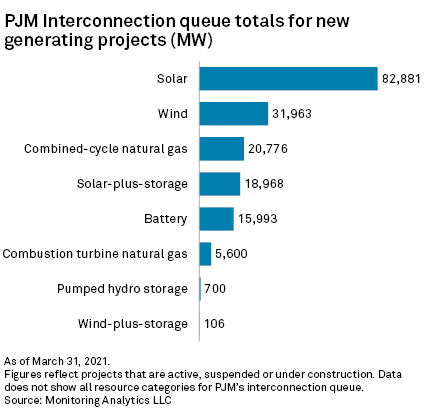S&P Global Offerings
Featured Topics
Featured Products
Events
S&P Global Offerings
Featured Topics
Featured Products
Events
S&P Global Offerings
Featured Topics
Featured Products
Events
Banking & Capital Markets
Economy & Finance
Energy Transition & Sustainability
Technology & Innovation
Podcasts & Newsletters
Banking & Capital Markets
Economy & Finance
Energy Transition & Sustainability
Technology & Innovation
Podcasts & Newsletters
S&P Global Offerings
Featured Topics
Featured Products
Events
3 Aug, 2021

By Zack Hale
The Federal Energy Regulatory Commission on July 30 accepted new capacity market rules proposed by the PJM Interconnection that aim to more accurately value the grid reliability contributions of renewable and energy storage resources.
FERC's order resolves an inquiry initiated after PJM proposed a 10-hour minimum run-time requirement for capacity storage resources in response to the agency's landmark energy storage rule for U.S. wholesale power markets, Order 841. Renewable energy and storage advocates argued the 10-hour run-time requirement would undervalue the contributions of many energy storage facilities by shutting them out from the capacity market.
Valuing those contributions of variable energy resources is a challenge because their value declines as renewable energy and storage penetration increases.
 |
PJM's stakeholder proposal (ER21-278) in October 2020 — dubbed the Effective Load Carrying Capability, or ELCC, proposal — established three different types of ELCC resources: variable resources, limited duration resources and combination resources.
The approved proposal establishes multiple storage classes with maximum durations of 4 hours, 6 hours, 8 hours and 10 hours.
The framework was cheered by clean energy advocates but opposed by PJM's independent market monitor, which favored valuing energy storage assets by their marginal reliability benefit as opposed to their average reliability benefit. Under the marginal approach, for example, a "first-in" resource would be assigned a capacity contribution rate of 60% versus just 1.3% for a "last-in" resource. In comparison, PJM's average approach would apply the same 20% assumed capacity contribution to all resources within that class.
Energy Storage Association Interim CEO Jason Burwen said the order removes a key barrier for storage in the PJM capacity market. "A whole new market awaits!" Burwen said on Twitter.
No 'single' correct method
PJM, therefore, submitted an updated ELCC proposal in June that eliminated the transition mechanism.
"Because selecting an ELCC method requires consideration of various complex tradeoffs, there is no single established just and reasonable ELCC approach," FERC said.
Commissioner Mark Christie disagreed with that reasoning in dissent, arguing that PJM's average approach could cost consumers and threaten grid reliability.
"It comes down to this for me: PJM's ELCC may well force consumers to pay for capacity that does not deliver or to overpay for the amount of capacity that the resource does deliver," Christie said. "That is both a cost problem and a reliability problem."
Christie also expressed concern that the new ELCC framework will not apply to existing thermal generators, something clean energy interests had called for.
But Commissioner James Danly argued in a concurrence that PJM has nevertheless met its "just and reasonable" burden under Section 205 of the Federal Power Act.
"Commissioner Christie may well be — in fact, probably is — correct that a marginal approach to allocating capacity to individual resources would be preferable to PJM's proposed resource-class based averaging mechanism," Danly said. "Should parties seek rehearing, I urge them to concentrate their pleadings on why PJM's proposal is not just and reasonable or why it is unduly discriminatory or preferential. That, ultimately, is all we are called upon to decide here."
Siding with clean energy groups, FERC also directed PJM to make another informational filing within 30 days to ensure transparency around the data and methodology underlying its new ELCC framework.
